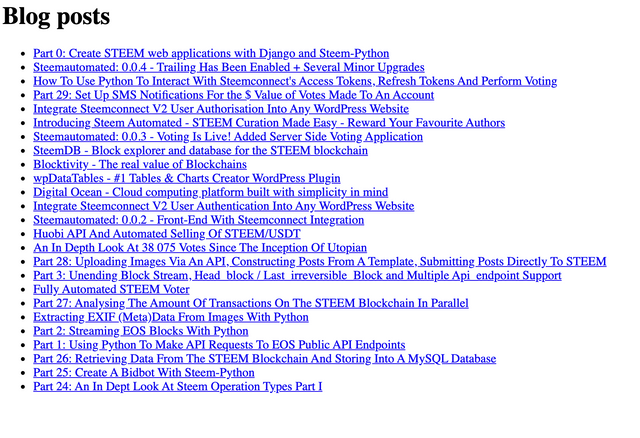Part 1: Using the URL to dynamically pull data via the Steem API and parse to html

This tutorial is part of a series where different aspects of quickly creating and deploying STEEM web applications by using the Django framework as well as Beem are discussed. Knowledge of programming with Python is advised, as well as HTML and CSS.
Repository
https://github.com/holgern/beem
https://github.com/django/django
What will I learn
- Extracting variables from the url
- Data collection inside a generic view
- Parsing data to a template
Requirements
- Python 3.7
- Django 2.1.5
- Beem 0.20.17
- Gunicorn 19.9.0
- Git
- Heroku
- Pipenv
Difficulty
- basic
Tutorial
Preface
Django allows for quick development of web applications and since it uses Python as it's main programming language it also allows for easy combition with the Beem library to develop STEEM web applications. This part will showcase how the url can be used to pass variables to dynamically pull data via an API and parse this into a template. Part 0 is recommended to understand the workflow.
Setup
Create a new folder for the project and set up a virtual environment with all the required packages. Start a new Django project steem_account.
$ cd ~/
$ mkdir steem_account
$ cd steem_account
$ pipenv install django==2.1.5
$ pipenv shell
(steem_account) $ pip install beem==0.20.17
(steem_account) $ pip install gunicorn==19.9.0
(steem_account) $ django-admin startproject steem_account .
Extracting variables from the url
Create a new app called posts. This app will be used to show the last posts of a specific user, which username will be retrieved from the url. Like https://www.steemit.com/@steempytutorials does. This can be achieved by setting up url paths.
(steem_account)$ python manage.py startapp posts
(steem_account)$ touch posts/urls.py
First register the new app in settings.py.
INSTALLED_APPS = [
'django.contrib.admin',
'django.contrib.auth',
'django.contrib.contenttypes',
'django.contrib.sessions',
'django.contrib.messages',
'django.contrib.staticfiles',
'posts.apps.PostsConfig', # new
]
Configure the main urls.py to direct to posts.urls on a empty path '' with include().
# steem_account/urls.py
from django.contrib import admin
from django.urls import path, include
urlpatterns = [
path('admin/', admin.site.urls),
path('', include('posts.urls')),
]
Now set up urls.py in posts to capture anything after the @ in the url. This is done by using @<slug:account>/ which captures everything after the @ and before a /. Slug tells Django to capture a string and account is the name of how the variable will be called to call it later on.
# posts/urls.py
from django.urls import path
from .views import HomePageView
urlpatterns = [
path('@<slug:account>/', HomePageView.as_view(), name='home')
]
Data collection inside a generic view
Django has several generic views which can be used to parse data to a html template. Normally this is set up by using models which refer to a database. In this case however Beem will be used to collect the data via an API.
# posts/views.py
from django.shortcuts import render
from django.http import HttpResponse
from django.views.generic import ListView
from django.http import HttpResponseNotFound
from .services import account_history
from beem.exceptions import AccountDoesNotExistsException
# View for the homepage that will display blog posts of the author
# in a list.
class HomePageView(ListView):
template_name = 'home.html'
context_object_name = 'all_posts_list'
# Try to get blog posts from account, if the account does exist
# return not found. Override the queryset with the obtained data.
def get(self, request, *args, **kwargs):
try:
self.queryset = account_history(kwargs['account'])
except AccountDoesNotExistsException:
print('Account does not exist')
return HttpResponseNotFound("Invalid account")
# Use the original function to generate the html reponse.
return super().get(request, *args, **kwargs)
ListView is a generic view to render lists. The template_name refers to the .html file the data will be parsed to. context_object_name refers to the name of the data list. More on this later on. By overriding queryset any data source can be used. The view gets called on GET request and the account variable captured is passed inside kwargs. Overriding the default get() method allows access to the account variable and call account_history(). Then the original get() method is called by returning super().get(request, *args, **kwargs).
services.py still has to be created which contains the functions to interact with the STEEM nodes by using Beem.
(steem_account)$ touch posts/services.py
# posts/services.py
from beem.blockchain import Blockchain
from beem.account import Account
from beem.comment import Comment
from beem import Steem
# retrieve account blog history
def account_history(username):
stm = Steem("https://steemd.minnowsupportproject.org")
account = Account(username, steem_instance=stm)
return account.blog_history(limit=25, reblogs=False)
Calling account_history() return a generator which contains the blog posts inside Comment() objects.
<Comment @steempytutorials/part-0-create-steem-web-applications-with-django-and-steem-python>
<Comment @steempytutorials/steemautomated-0-0-4-trailing-has-been-enabled-several-minor-upgrades>
<Comment @steempytutorials/how-to-use-python-to-interact-with-steemconnect-s-access-tokens-refresh-tokens-and-perform-voting>
<Comment @steempytutorials/part-29-set-up-sms-notifications-for-the-usd-value-of-votes-made-to-an-account>
<Comment @steempytutorials/integrate-steemconnect-v2-user-authorisation-into-any-wordpress-website>
<Comment @steempytutorials/introducing-steem-automated-steem-curation-made-easy-reward-your-favourite-authors>
<Comment @steempytutorials/steemautomated-0-0-3-voting-is-live-added-server-side-voting-application>
<Comment @steempytutorials/steemdb-block-explorer-and-database-for-the-steem-blockchain>
Parsing data to a template
At the moment when a users enter a url with a @ and some additional characters before a / a get request gets send to the server. The server then redirects to the HomePageView which extracts the account name to get the account blog history via Beem. The view then parses this data into home.html, which does not exist yet. The html files are referred to as templates and should be stored in a separate folder.
(steem_account) $ mkdir templates
(steem_account) $ touch templates/home.html
Register the new folder in settings.py
# steem_account/settings.py
TEMPLATES = [
{
'BACKEND': 'django.template.backends.django.DjangoTemplates',
'DIRS': [os.path.join(BASE_DIR, 'templates')], # new
Now add the following code to home.html
# templates/home.html
<h1>Blog posts</h1>
<ul>
{% for post in all_posts_list %}
<li><a href="https://www.steemit.com/{{ post.authorperm }}">{{ post.title }}</a></li>
{% endfor %}
</ul>
The Python code needs to be between {% %} for logic or {{}} for variables. This allows for easy creation of html which is repeated and dynamic. all_posts_list is the name set earlier in the view as context_object_name. This html file contains a simple list where each entry has a link to the blog post of the user and the title of the post. Both the authorperm and title are accessed within the Comment() object.
Version control and deployment
Make sure that the pipfile has the following packages and lock the file.
[packages]
django = "==2.1.5"
beem = "==0.20.17"
gunicorn = "==19.9.0"
pyyaml = "==4.2b4"
(steem_account) $ pipenv lock
Heroku requires a Procfile, create it and add the following line.
(steem_account) $ touch Procfile
# ./Procfile
web: gunicorn steem_account.wsgi --log-file -
Now set the ALLOWED_HOSTS in settings.py so the website can run from any ip.
# steem_account/settings.py
ALLOWED_HOSTS = ['*']
Create a git repository online. Now initiate git in the folder, add all the files, commit and push.
(django) $ git init
(django) $ git add -A
(django) $ git commit -m 'initial commit'
(django) $ git remote add origin https://github.com/Juless89/django-steem-stats.git
(django) $ git push -u origin master
When using git for the first time it is recommend to set the following variables.
$ git config --global user.name "Your Name"
$ git config --global user.email "[email protected]"
Create an Heroku app and link it.
(django) $ heroku login
(django) $ heroku create
Creating app... done, ⬢ guarded-crag-10235
https://guarded-crag-10235.herokuapp.com/ | https://git.heroku.com/guarded-crag-10235.git
(django) $ heroku git:remote -a guarded-crag-10235
set git remote heroku to https://git.heroku.com/guarded-crag-10235.git
Disable static files on Henroku and push the code.
(django) $ heroku config:set DISABLE_COLLECTSTATIC=1
(django) $ git push heroku master
Activate the Henroku app, set it to level 1. Level 1 is free to use. Then open the app to see it live. As this is a free service the apps get put to sleep when not used for 30 min.
(django) $ heroku ps:scale web=1
(django) $ heroku open

https://guarded-crag-10235.herokuapp.com/@steempytutorials
Curriculum
The code for this tutorial can be found on Github!
This tutorial was written by @juliank.
Thank you for your contribution @steempytutorials.
After analyzing your tutorial we suggest the following:
We suggest you put some images of the final result of what was developed.
Your tutorial is very well structured and well explained. Good work on developing this tutorial.
Your contribution has been evaluated according to Utopian policies and guidelines, as well as a predefined set of questions pertaining to the category.
To view those questions and the relevant answers related to your post, click here.
Need help? Chat with us on Discord.
[utopian-moderator]
Thank you for your review, @portugalcoin! Keep up the good work!
Hi @steempytutorials!
Your post was upvoted by @steem-ua, new Steem dApp, using UserAuthority for algorithmic post curation!
Your post is eligible for our upvote, thanks to our collaboration with @utopian-io!
Feel free to join our @steem-ua Discord server
Hey, @steempytutorials!
Thanks for contributing on Utopian.
We’re already looking forward to your next contribution!
Get higher incentives and support Utopian.io!
Simply set @utopian.pay as a 5% (or higher) payout beneficiary on your contribution post (via SteemPlus or Steeditor).
Want to chat? Join us on Discord https://discord.gg/h52nFrV.
Vote for Utopian Witness!